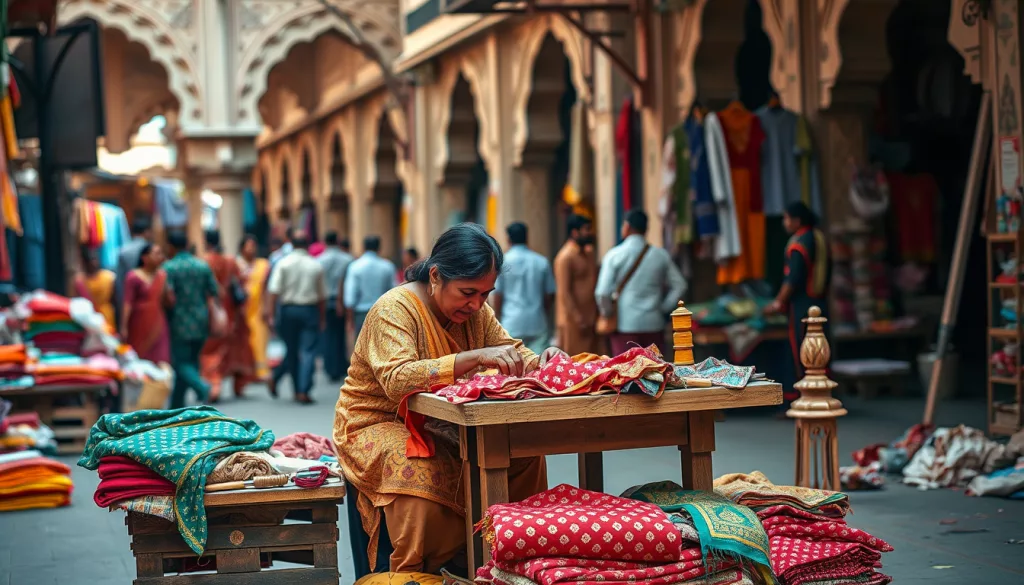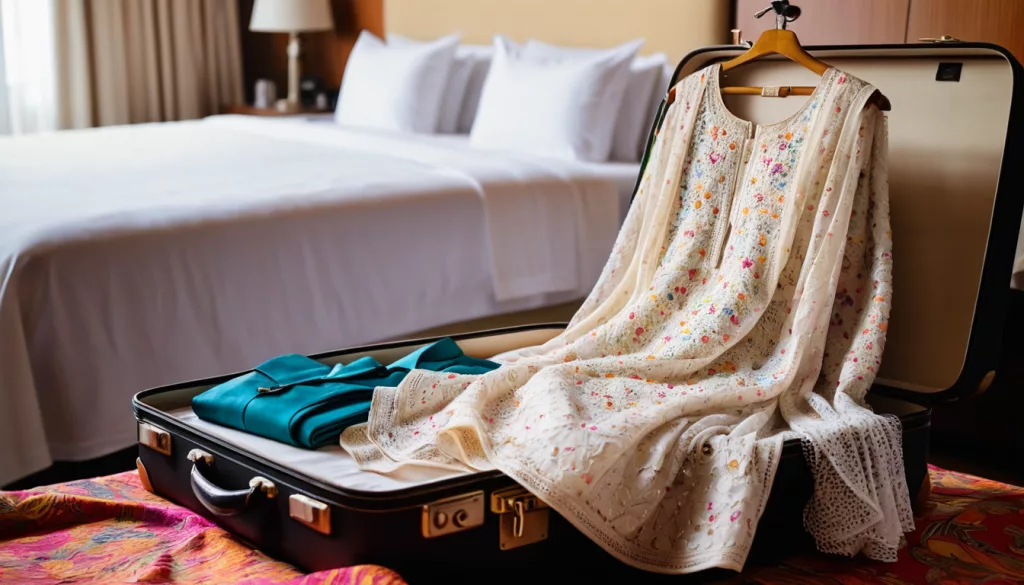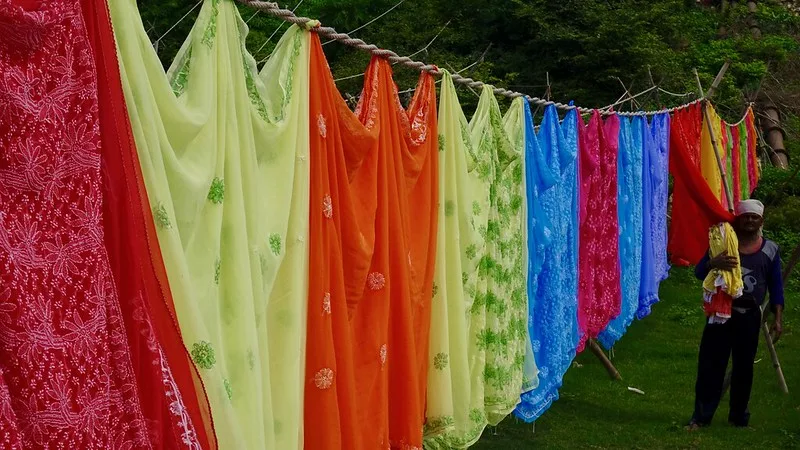Textile Trails of India: Discovering the Intricate Beauty of Chikankari in Lucknow.
Introduction
In the heart of Lucknow, a city humming with history, heritage, and craftsmanship, there’s a particular market scene that captures the spirit of India’s textile artistry. Rows of fabrics dance in the breeze, each piece telling a story of painstaking effort, artistry, and tradition. This is the home of chikankari—an embroidery art that has traveled through time, from royal Mughal courts to the modern world. Today, as travelers search for meaningful connections to local cultures, the allure of chikankari offers a perfect opportunity to explore an ancient craft in its birthplace.
In this post, we’ll dive into the rich history, intricate process, and enduring beauty of chikankari. We’ll guide you through Lucknow’s famous chikan markets, introduce you to the artisans behind this craft, and share tips on how to bring a piece of this legacy home with you.
The History of Chikankari
Origins and Legend
Chikankari’s roots reach deep into history, its origin often linked to Persian influence brought to India by the Mughals. Some legends attribute chikankari to Nur Jahan, the beloved wife of Emperor Jahangir, who, captivated by the Persian art of floral embroidery, popularized it among Mughal nobility. Others believe chikankari existed even before the Mughals, with ancient Indian texts referencing similar embroidery techniques.
Evolution Over Time
Originally a luxury for the royal class, chikankari flourished under Mughal patronage, evolving with each generation. But as colonial rule reshaped India’s economy, chikankari faced challenges, with demand for Western textiles threatening traditional crafts. Post-independence, however, efforts to preserve chikankari grew, driven by both government initiatives and grassroots support. Today, it’s celebrated as both a heritage art and a thriving modern craft.
Cultural Significance
Chikankari is more than just decorative stitching—it’s a cultural symbol. It carries Lucknow’s history, connecting generations through the hands of its artisans. This craft represents elegance, resilience, and an enduring commitment to artistry, linking artisans, traders, and enthusiasts through a shared passion for preserving the past.
The Art of Chikankari
Craftsmanship Process
Creating chikankari is a labor of love, involving a series of intricate steps and a remarkable attention to detail:
- Designing: Artisans or designers begin by sketching patterns on the fabric, often using washable ink. Popular motifs include flowers, vines, paisleys, and other elements inspired by nature, which lend a soft, organic charm to the embroidery.
- Stitching Techniques: Using fine needles, artisans work with an array of stitches, each with its own purpose. Tepchi (running stitch) creates the outline, murri (knot stitch) adds texture, jaali (netting stitch) creates delicate lattices, and bakhiya (shadow work) produces a subtle, shadowed effect on the fabric.
- Washing and Finishing: Once the embroidery is complete, the fabric is carefully washed to remove the ink marks and reveal the pure white or pastel designs. After drying and pressing, each piece is examined to ensure its quality.
Skill and Patience of Artisans
The artisans of chikankari are masters of patience, spending days, even weeks, on a single piece. For many, chikankari is not just a livelihood but an expression of pride. As one artisan shared, “Each stitch is a gift of time and love.” For these craftsmen and women, chikankari represents a lifelong dedication to an art form passed down through generations.
Artistry Challenges
With the rise of machine-made textiles, chikankari faces challenges from mass-produced alternatives. But there remains a unique charm in handmade work, with each piece bearing the artisan’s touch. Many artisans now work with NGOs and cooperatives, which help preserve their traditional methods and provide fair wages.
Experiencing Chikankari in Lucknow

Visiting Lucknow’s Chikan Markets
If you’re visiting Lucknow, exploring its bustling markets is essential to experiencing chikankari in its authentic form.
- Chowk Market: One of the oldest markets in Lucknow, Chowk is renowned for its range of chikankari products, from simple scarves to luxurious sarees. Wandering its lanes offers a sensory delight as artisans display their vibrant handiwork.
- Hazratganj Market: Blending old-world charm with modern appeal, Hazratganj houses chic boutiques as well as budget-friendly shops where you can find chikankari pieces suited for any occasion.
- Nakhas Market: Known for its boisterous energy, Nakhas Market offers traditional handicrafts, including chikankari, and is popular among both locals and tourists. Be prepared to haggle and discover hidden gems.
Best Boutiques and Artisans’ Workshops
For those seeking premium or custom pieces, Lucknow is home to family-run boutiques and small workshops. Seek out artisans who continue traditional techniques, as these pieces are known for their intricate craftsmanship and durability.
Tips for Spotting Authentic Chikankari
To ensure you’re purchasing a genuine hand-embroidered piece:
- Look for Irregularities: Handmade chikankari will have slight irregularities, a sign that it was crafted by hand.
- Feel the Fabric: Authentic chikankari is typically done on fine muslin or cotton, so if the fabric feels too stiff or synthetic, it may not be genuine.
- Check the Reverse Side: The backside of an authentic chikankari piece often reveals threads and knots that indicate hand-stitching.
Bringing Chikankari Home

Choosing the Perfect Piece
Selecting the right chikankari piece is part of the experience. From classic kurtas to elaborate sarees, each garment offers a unique blend of craftsmanship and style. Think about your style preferences, as well as how each piece might fit into your wardrobe.
Sustainable Shopping Tips
To support sustainable practices, consider buying directly from artisans or certified boutiques that focus on fair trade. These establishments ensure that the artisans are compensated fairly and work under safe conditions, helping preserve the craft for future generations.
Caring for Your Chikankari
Chikankari is delicate, so taking care of it properly ensures it will last. Use gentle washing techniques, avoid harsh detergents, and store your garments in a dry, cool place away from sunlight. With proper care, your chikankari can remain as beautiful as the day you purchased it.
The Future of Chikankari
Revitalizing Traditional Craft
Today’s designers are experimenting with new styles, from chikankari on denim jackets to minimalist chikankari decor items. These contemporary applications introduce chikankari to a younger audience, helping keep the craft alive and evolving.
Challenges and Innovations
Chikankari faces challenges, especially from imitation products. However, many artisans are adapting, exploring bolder colors, diverse fabrics, and collaborating with global brands to showcase chikankari in fresh, modern contexts.
Support and Advocacy
If you’re moved by the story of chikankari, support the artisans by sharing their work or advocating for fair trade in traditional crafts. Better yet, add Lucknow to your travel list and experience this timeless craft firsthand.
How to Plan a Fulfilling Holiday (and Actually Enjoy It)
Ever returned from a vacation and felt like you needed another one to recover? Same….
Is Space the Next Tourist Hotspot? Exploring the Out-of-This-World Vacations of 2054
Imagine this: you’re floating in zero gravity, sipping on a space-themed drink (with a sealed…
Cinque Terre vs. Amalfi Coast: Why Italy’s Laid-Back Gem Wins Every Time
Picture this: pastel-colored houses perched on rugged cliffs, shimmering turquoise waters below, and a sunset…
Further Reading on Chikankari
If you’re inspired to dive deeper into the world of chikankari and explore its rich history, techniques, and cultural impact, here are some recommended sources to expand your knowledge:
- “Threads of Lucknow: Chikankari Embroidery in India” by Monisha Ahmed
This book explores the history, craftsmanship, and cultural significance of chikankari, providing an in-depth look at how the art form developed and evolved in Lucknow. With stunning photographs and detailed explanations of stitching techniques, it’s a valuable resource for anyone interested in textile arts. - Crafts Council of India – Chikankari Profile
The Crafts Council of India’s website offers an informative profile on chikankari, including its origins, types of stitches, and current challenges faced by artisans. It’s a good place to get a brief, reliable overview of the craft. - “Lucknow: The Last Phase of an Oriental Culture” by Abdul Halim Sharar
This classic text on Lucknow’s history covers the broader cultural context in which chikankari developed, particularly the lifestyle and traditions of the Mughal courts. While not solely focused on chikankari, it provides excellent background on the city that brought the art form to life. - Indian National Trust for Art and Cultural Heritage (INTACH) – Heritage Crafts of India
INTACH’s publications and reports on Indian heritage crafts include profiles on chikankari and similar embroidery traditions. They often discuss preservation efforts, offering insights into the ongoing initiatives to keep chikankari alive. - NGO Websites Supporting Chikankari Artisans
Websites of NGOs like SEWA (Self Employed Women’s Association) and Dastkar, both of which support traditional artisans, provide valuable information on current social and economic issues facing chikankari artisans, as well as details on sustainable shopping options.






